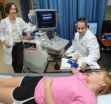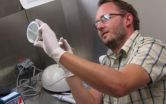(Press-News.org) ANN ARBOR—It's a sad but familiar scene near the grounds of many medical campuses: hospital-gowned patients, some toting rolling IV poles, huddled in clumps under bus shelters or warming areas, smoking cigarettes.
Smoking causes 30 percent of all cancer deaths and 87 percent of all lung cancer deaths. Yet, roughly 50 percent to 83 percent of cancer patients keep smoking after a cancer diagnosis, through treatment and beyond, says Sonia Duffy, University of Michigan School of Nursing researcher. For patients who quit on their own, relapse rates (as in the general population) are as high as 85 percent.
Yet, continued smoking severely hampers cancer treatment, increases cancer recurrence and decreases survival, she says.
While it's easy to dismiss smoking as a lack of discipline or a disregard for one's own health, it's a much more complicated picture for these patients, says Duffy, lead researcher on the review paper, "Why Do Cancer Patients Smoke and What Can Providers Do About It," which appears in the journal Community Oncology.
"Ours is the first comprehensive review study to examine reasons why the very cause of the cancer, namely smoking, in many cases isn't treated," said Duffy, who said she wasn't prepared to find so many hurdles hindering smoking cessation in cancer patients.
"I think what surprised me when I did the review was the multitude of issues that cancer patients face, and that there are so many variables affecting why they don't get treatment, and if they do get treatment, why they may not respond. Nicotine addiction, health issues, emotional issues, psychological issues and system level issues are all in the way."
Other obstacles include limited access to quit-smoking programs, little social support, sleep deprivation, poor nutrition, lack of confidence in being able to quit and socioeconomic status. After back-to-back appointments and grueling chemotherapy or radiation protocols, many cancer patients simply lack time or energy to attend quit-smoking programs, Duffy says.
Depression is another big barrier to quitting smoking, and among cancer patients it's as high as 58 percent, compared to 10 percent in the general population, she says. And, while most lung cancer patients understand the relationship between smoking and their diagnosis, head-and-neck-cancer patients often don't make the connection.
Surprisingly, Duffy's research suggests that only 56 percent of family physicians urge their cancer patients to quit smoking. Most oncology providers suggest quitting, but the oncologist's main focus is on cancer treatment. Duffy's paper suggests that nurse-administered stop-smoking interventions may be the best way to reach cancer patients who smoke, yet many nurses are not trained to conduct cessation interventions. Duffy's next project will examine ways to specifically design quit-smoking programs for nurses to administer to cancer patients.
Duffy also has appointments at the Ann Arbor VA Center for Clinical Management Research and the U-M departments of Otolaryngology and Psychiatry. Other authors include Samantha Louzon of the Ann Arbor VA Center for Clinical Management Research and Ellen Gritz of the University of Texas MD Anderson Cancer Center.
###
Study: www.sciencedirect.com/science/article/pii/S1548531512006420
Sonia Duffy: http://sitemaker.umich.edu/sonia.duffy/home
U-M School of Nursing: http://nursing.umich.edu
Ann Arbor VA Clinical Management Research: www.annarbor.hsrd.research.va.gov
END
When faced with scandal or wrongdoing, corporations should stick to the facts in their post-crisis messaging, according to a new study from researchers at Rice University, the University of Georgia and the University of Maryland – College Park.
The study, "Managing the message: The effects of firm actions and industry spillovers on media coverage following wrongdoing," examined quarterly media coverage of 45 U.S. public toy companies a 10-year period and over 5,500 press releases generated by the companies during that time.
Almost half of the companies surveyed conducted ...
Some people live their lives by the motto "no risk - no fun!" and avoid hardly any risks. Others are clearly more cautious and focus primarily on safety when investing and for other business activities. Scientists from the University of Bonn in cooperation with colleagues from the University of Zurich studied the attitudes towards risk in a group of 56 subjects. They found that in people who preferred safety, certain regions of the brain show a higher level of activation when they are confronted with quite unforeseeable situations. In addition, they do not distinguish as ...
AUGUSTA, Ga. – The first evidence of blood vessel dysfunction has been found in a small cohort of generally healthy young people with cystic fibrosis, researchers report.
"Even though the lung function in these kids is fine at this point, there is evidence of vascular dysfunction and exercise intolerance," said Dr. Ryan A. Harris, clinical exercise physiologist at the Medical College of Georgia and Institute of Public and Preventive Health at Georgia Health Sciences University. "We think this blood vessel dysfunction could be contributing to their exercise intolerance, ...
It all started with a crab apple tree.
Two years ago, a 71-year-old Indiana man impaled his hand on a branch after cutting down a dead tree. The wound caused an infection that led scientists to discover a new bacterium and solve a mystery about how bacteria came to live inside insects.
On Oct. 15, 2010, Thomas Fritz, a retired inventor, engineer and volunteer firefighter, cut down a dead, 10-foot-tall crab apple tree outside his home near Evansville, Ind.
As he dragged away the debris, he got tangled in it and fell. A small branch impaled his right hand in the fleshy ...
Visualize a dusty place where stream beds are sand and lakes are flats of dried mud. Are we on Mars? In fact, we're on arid parts of Earth, a planet where water covers some 70 percent of the surface.
How long will water be readily available to nourish life here?
Scientists funded by the National Science Foundation's (NSF) Dynamics of Coupled Natural and Human Systems (CNH) program are finding new answers.
NSF-supported CNH researchers will address water resources management and policy in a changing world at the fall meeting of the American Geophysical Union (AGU), ...
MANHATTAN, Kan. -- The key to motivation in physical activity may be feeling inadequate. One Kansas State University researcher found that those who exercised with a teammate whom they perceived to be better increased their workout time and intensity by as much as 200 percent.
Brandon Irwin, assistant professor of kinesiology, was the principle investigator in a study that tested whether individuals engage in more intense physical activity when alone, with a virtual partner or competing against a teammate.
"People like to exercise with others and make it a social activity," ...
CAMBRIDGE, Mass. — The quest to harness a broader spectrum of sunlight's energy to produce electricity has taken a radically new turn, with the proposal of a "solar energy funnel" that takes advantage of materials under elastic strain.
"We're trying to use elastic strains to produce unprecedented properties," says Ju Li, an MIT professor and corresponding author of a paper describing the new solar-funnel concept that was published this week in the journal Nature Photonics.
In this case, the "funnel" is a metaphor: Electrons and their counterparts, holes — which are ...
An insect growth regulator is one of the latest technologies U.S. Department of Agriculture (USDA) scientists are adding to their arsenal to help fight house flies that spread bacteria to food.
Agricultural Research Service (ARS) scientists at the agency's Center for Medical, Agricultural, and Veterinary Entomology in Gainesville, Fla., are using an insect growth regulator called pyriproxyfen to kill house flies that spread bacteria that can cause diarrhea and other illnesses. When pyriproxyfen is applied to larval breeding sites such as manure, it mimics a hormone in ...
New combinations of medical imaging technologies hold promise for improved early disease screening, cancer staging, therapeutic assessment, and other aspects of personalized medicine, according to Ge Wang, director of Virginia Tech's Center for Biomedical Imaging, in a recent paper that appeared in the refereed journal PLOS ONE.
The integration of multiple major tomographic scanners into a single framework "is a new way of thinking in the biomedical imaging world" and is evolving into a "grand fusion" of many imaging modalities known as "omni-tomography," explained Wang, ...
Durham, NC – The question of how life began on a molecular level has been a longstanding problem in science. However, recent mathematical research sheds light on a possible mechanism by which life may have gotten a foothold in the chemical soup that existed on the early Earth.
Researchers have proposed several competing theories for how life on Earth could have gotten its start, even before the first genes or living cells came to be. Despite differences between various proposed scenarios, one theme they all have in common is a network of molecules that have the ability ...



